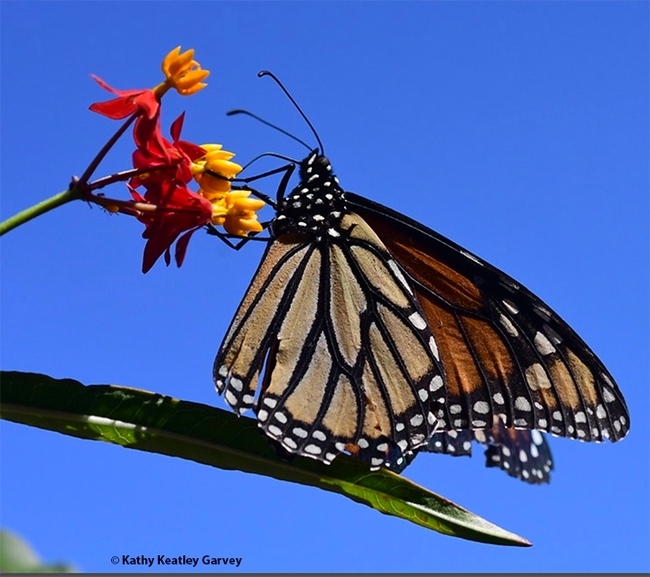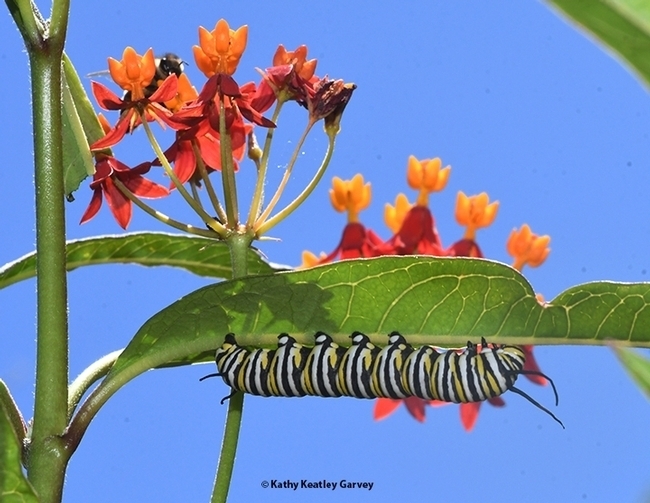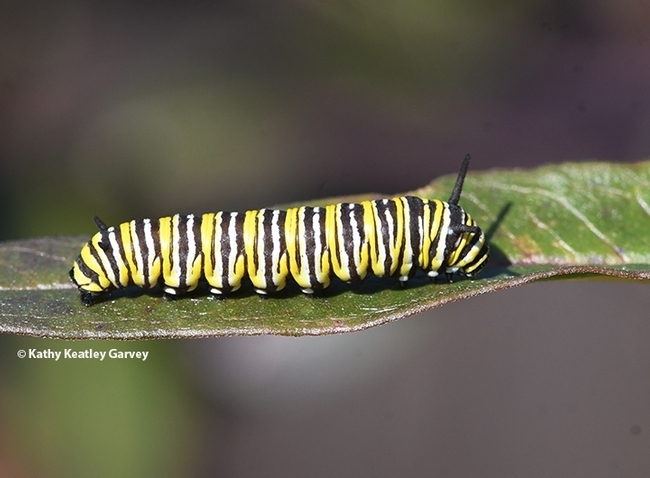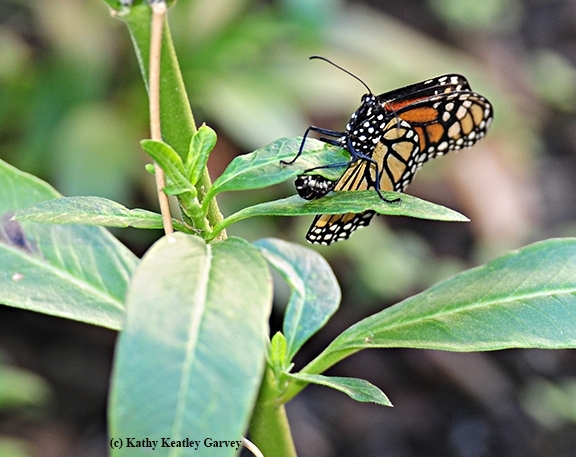- Author: Kathy Keatley Garvey

No, say many scientists, including Hugh Dingle, professor emeritus of entomology, behavior and evolution at UC Davis.
Professor Dingle is an internationally known expert on animal migration. He's researched animal migration for some 50 years. In the last 20 years or so, he has focused on monarch butterflies. He has authored two editions of Migration: The Biology of Life on the Move and some 100 papers. National Geographic featured Professor Dingle in its cover story on “Great Migrations” in November 2010. LiveScience interviewed him for its November 2010 piece on “Why Do Animals Migrate?” (See news story that includes his biographical information)
Professor Dingle, a resident of Marin County, responded to a recent front-page article in a Marin County paper about the California ban on tropical milkweed. Banning tropical milkweed, A. curassavica, will NOT save the monarch, Dingle emailed the reporter. In fact, he said, the ban will "essentially have zero effect on monarchs" and "no one should rush out and pull out their tropical milkweed as it would be a waste of time and effort. Nurseries should also be able to continue to sell it."
The professor shared this with Bug Squad:
- "There is not enough tropical milkweed planted to have much influence (see the amount of A. syriaca and A. fascicularis throughout the American West not to mention various other species like A. erosa, cordifolia, californica, etc.) Yes, there are parasites on A. curassavica as there are on ALL milkweeds."
- "There are populations of monarchs that are doing just fine feeding exclusively on A. curassavica (e.g. on many Pacific Islands, such as Guam where I have studied them."
- "Migration and the diapause that accompanies it in the fall are determined by shortening photoperiod and temperature (warm temps can override short days hence the issue with climate change). There is no significant influence of food plant."
Tropical milkweed has been in California for more than a century. It's along our roadsides, in our parks, in our gardens. If the California border were moved a bit, it would be a native plant. Yet the California Department of Food and Agriculture, influenced by native plant proponents, has deemed it a "noxious weed."
Professor Dingle is among many scientists who point out that milkWEED (despite the "weed" in its name), is NOT a noxious plant. If you're standing on the California-Mexico border, on one side it's a noxious weed (evil, dangerous, nasty, get-rid-of-it-now, how-dare-you) and inches away, it's a beautiful host plant for monarchs, and a great nectar source for monarchs and other pollinators, including honey bees, syrphid flies and hummingbirds.
The California Department of Fish and Wildlife's ban on rearing monarchs (no one can do so without a permit) is unsettling to many. Entomologist Jeff Smith, who curates the Lepidoptera collection at the Bohart Museum of Entomology at UC Davis and is a member of the Lepidopterists' Society, reared a few monarchs as a child, but laments that today, no one in California can do so without a permit, and it's difficult to get a permit unless you're a researcher.
In the latest edition of the Lepidopterists' Society newsletter, Robert Michael Pyle (founder of the Xerces Society for Invertebrate Conservation) and David Wagner wrote a piece, "Keep Nets in the Hands of Kids--and Others!"
An excerpt: "Give a kid a net, and watch her go! Not that the net is the only porthole into our world. For some it could be raising caterpillars or tadpoles, keeping mantises and walking sticks as pets, or examining ants, beetles, and grass- hoppers through a magnifying glass. But the common feature is having hands-on, unfettered exploration of the living world as children. Many life-science professionals, including RMP's cardiologist, ascribe their passion for life and nature to hunting bugs, crawdads, and pollywogs in their youth. This is why the Society instituted the Outernet Project, to get nets into the hands of children—a task made more difficult not only by the umbilical USB connection now present at birth and children's subsequent inseparability from electronica, but also by the loss of BioQuip. Is the coup de grâce for children's face-to-face fascination with small-scale life to be delivered now by well-intended but ill-considered regulation?"
So Very Controversial. Amazing that tropical milkweed issue has become so very controversial. You cannot post an image of a egg, caterpillar, chrysalis or a monarch on A. curassavica--a food and nectar source--without a native plant proponent attacking you and ordering you to remove that tropical plant in your garden immediately. (Never mind that you are growing native milkweed as well.) One scientist told me: "They just want to control you and bully you."
In our pollinator garden in Vacaville, monarchs prefer tropical milkweed over the non-natives. Tropical is more toxic.
Mona Miller, who administers the popular Facebook page, Creating Habitat For Butterflies, Moths, & Pollinators, related: "Monarch are resilient insects, they have so many strategies to increase their population, but they do have their limits. We must stop pulling out tropical milkweed and cutting it back. Washing off all milkweed should suffice to clean off the OE spores. I emailed several scientists, no one could tell me that OE (Ophryocystis elektroscirrha is a protozoan parasite) has any way to attach to milkweed leaves other than getting caught in the hairs. Tropical milkweed has smooth leaves. Tropical milkweed has been in California since 1909, that is over 100 years. Totally eradicating tropical milkweed, just like totally eradicating all the eucalyptus trees (non-natives), would have a detrimental effect on the monarch population--perhaps it already has."
Indeed, folks should pay more attention to habitat loss and pesticide use, the real culprits of the monarch population decline.
Bohart Museum Open House. At any rate, be sure to attend the Bohart Museum of Entomology's open house on monarchs from 1 to 4 p.m., Saturday, Nov. 4 in Room 1124 of the Academic Surge Building, 455 Crocker Lane, UC Davis. It's free and family friendly. A number of scientists will be there to answer your questions.
Scheduled to participate are:
- UC Davis distinguished professor emeritus Art Shapiro of the Department of Evolution and Ecology, who has studied butterfly populations in central California since 1972 and maintains a research website, Art's Butterfly World.
- UC Davis emeritus professor Hugh Dingle, a worldwide authority on animal migration, including monarchs. He is the author of Migration: The Biology of Life on the Move (Oxford University Press), a sequel to the first edition published in 1996. See news story on the UC Davis Entomology and Nematology website.
- UC Davis professor Louie Yang, who does research on monarchs. Due to parental duties, he may be able to attend only the last part of the open house. See news story about his work.
- UC Davis professor Elizabeth Crone of the Department of Evolution and Ecology, formerly of Tufts University, who researches monarchs. See news story about the declining monarch population on the UC Davis Entomology and Nematology website.
The Bohart Museum houses a global collection of eight million insect specimens, plus a living insect petting zoo (Madagascar hissing cockroaches and stick insects, among others), and a insect-themed gift shop. UC Davis distinguished professor Lynn Kimsey has directed the Bohart Museum, founded in 1946, since 1990.

- Author: Kathy Keatley Garvey
It's Wednesday afternoon, Nov. 1 and a female monarch butterfly flutters into our Vacaville pollinator garden.
Me: "Welcome Ms. Monarch! Aren't you a little late for the migration?"
Ms. Monarch: "No, I'm just a late bloomer,. so to speak. I'm heading to Santa Cruz to join my buddies for the winter and then we'll return in February. Right now, I need some nectar, a little flight fuel, to make it to Santa Cruz, if you don't mind."
Me: "Help yourself, Ms. Monarch. Right now we have several plants blooming, including Mexican sunflower, tropical milkweed, zinnias, blanketflower, catmint, roses, foxgloves, and evening primrose. One of your sisters passed through here Oct. 21 and she laid eggs on the tropical milkweed, Asclepias curassavica. She ignored the native milkweed, Asclepias fascicularis, and the other natives we planted."
Ms. Monarch: "Thank you for giving us a choice."
Me: "You're welcome. But watch out for the spiders and praying mantises."
Ms. Monarch: "Hope they won't catch me!"
Me: "I'll check to see where they are. No, don't see them, but that doesn't mean they're not there."
Ms. Monarch, sipping nectar on the tropical milkweed: "This is delicious. You don't mind if I stay 'n sip, sip 'n stay, or awhile?"
Me: "We planted it for you and your brothers and sisters. Well, for other insects, too, like honey bees and syrphid flies, but mainly for you. There's talk, you know, about being endangered."
Ms. Monarch: "Will my sister's eggs survive?
Me: "Well, between the spiders, ants, wasps, lady beetles and milkweed bugs, we can't promise. Hey, even monarch caterpillars will eat the eggs. But we do know this: only 5 percent of the eggs make it to adulthood. So, the odds aren't good. Oops, gotta go. 'Bye for now."
Bohart Museum Open House on Saturday, Nov. 4
Want to talk to a scientist about monarch butterflies? Then you'll want to attend the Bohart Museum of Entomology open house on Saturday, Nov. 4 from 1 to 4 p.m. in Room 1124 of the Academic Surge Building, 455 Crocker Lane. Scientists will be there to answer your questions.
The event is free and family friendly and a great opportunity to learn more about Danaus plexippus.
The scientists will include:
- UC Davis distinguished professor emeritus Art Shapiro of the Department of Evolution and Ecology, who has studied butterfly populations in central California since 1972 and maintains a research website, Art's Butterfly World.
- UC Davis emeritus professor Hugh Dingle, a worldwide authority on animal migration, including monarchs. He is the author of Migration: The Biology of Life on the Move (Oxford University Press), a sequel to the first edition published in 1996. See news story on the UC Davis Entomology and Nematology website.
- UC Davis professor Louie Yang, who does research on monarchs. Due to parental duties, he may be able to attend only the last part of the open house. See news story about his work.
- UC Davis professor Elizabeth Crone of the Department of Evolution and Ecology, formerly of Tufts University, who researches monarchs. See news story about the declining monarch population on the UC Davis Entomology and Nematology website.
- UC Davis postdoctoral fellow Aramee Diethelm of the Elizabeth Crone lab. She holds a doctorate from the University of Nevada, Reno. Both her Ph.D. and postdoctoral work are on monarch butterflies.
The Bohart Museum houses a global collection of eight million insect specimens, plus a living insect petting zoo (Madagascar hissing cockroaches and stick insects, among others), and a insect-themed gift shop. UC Davis distinguished professor Lynn Kimsey has directed the Bohart Museum, founded in 1946, since 1990.
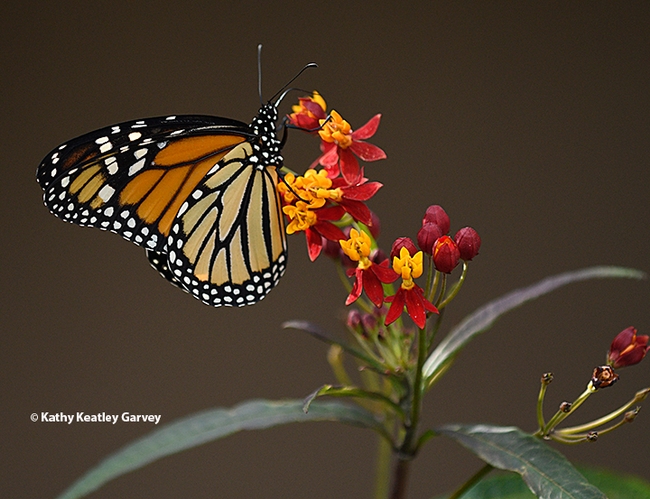
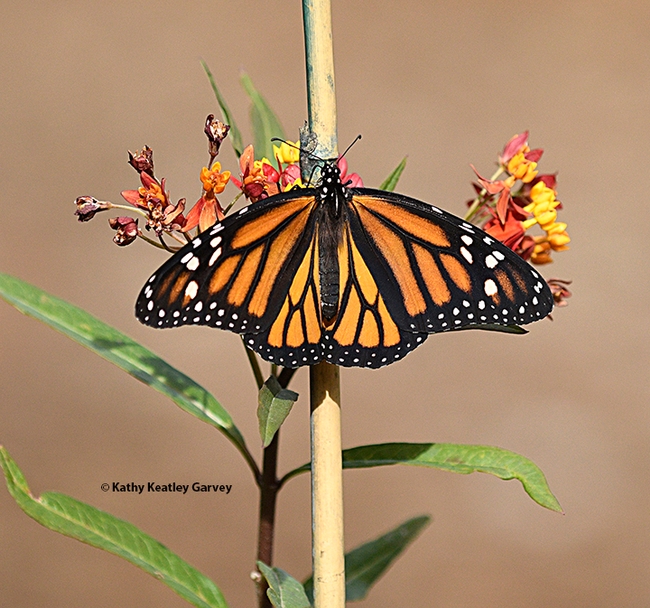

- Author: Kathy Keatley Garvey
And just like that, a female monarch butterfly fluttered into our Vacaville pollinator garden this morning, Aug. 10, and left a dozen or so calling cards: precious eggs.
We earlier saw a male monarch patrolling the garden on the morning of July 23, but he left to go find the girls.
So, total number of monarchs sighted in our garden so far this year: 2. (In 2016, we counted more than 300 eggs and caterpillars.)
Ms. Monarch deposited eggs on three milkweed plants: a narrow-leafed milkweed, Asclepias fascicularis, and two tropical milkweeds, Asclepias curassavica. She favored a lone tropical milkweed thriving in a planter. It's already attracted honey bees, leafcutter bees, syrphid flies, crab spiders, cabbage white butterflies, Gulf Fritillaries, mourning cloaks, gray hairstreaks, Western tiger swallowtails, ants, aphids, and a young praying mantis lying in wait.
Ms. Monarch totally ignored the showy milkweed, Asclepias speciosa, that towers over the garden. Not for me, she seemed to say. Ditto on the butterflyweed, Asclepias tuberosa.
We managed a few images of Ms. Monarch in flight, several images of her laying eggs, and a couple of the ever-so tiny eggs clinging beneath the leaves.
Welcome, Ms. Monarch. Now go tell all your buddies where to find the milkweed of your choice, and the rich nectar sources such as Mexican sunflowers (Tithonia rotunifola).
And you better warn them about that praying mantis...
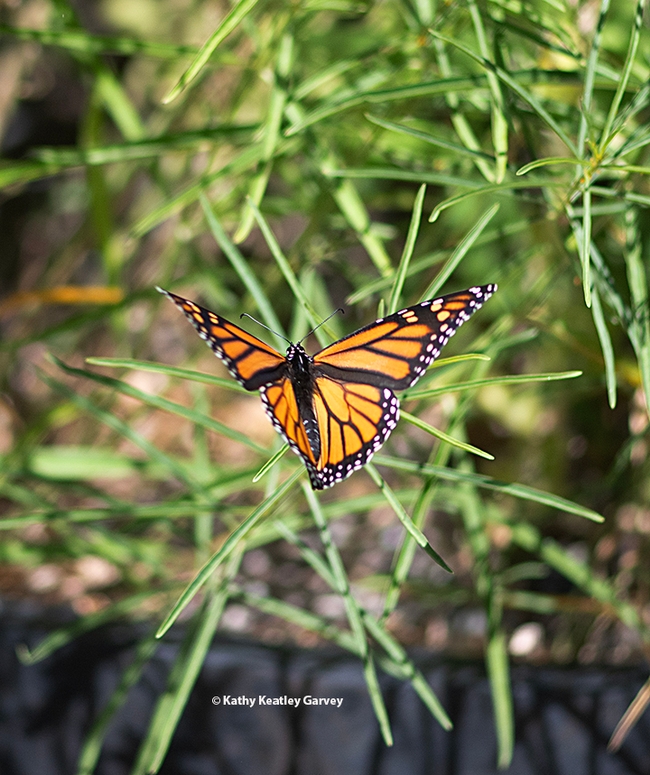
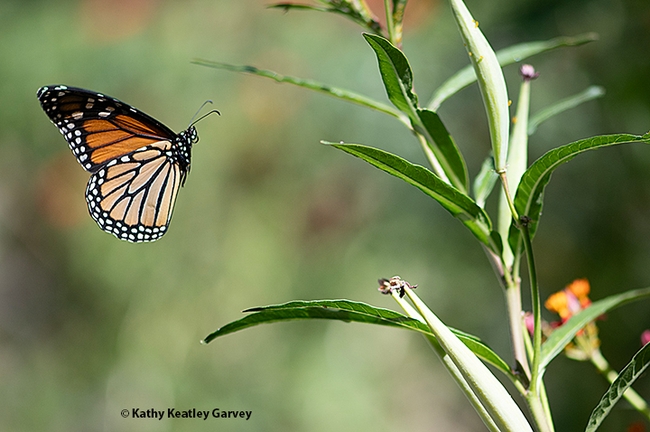
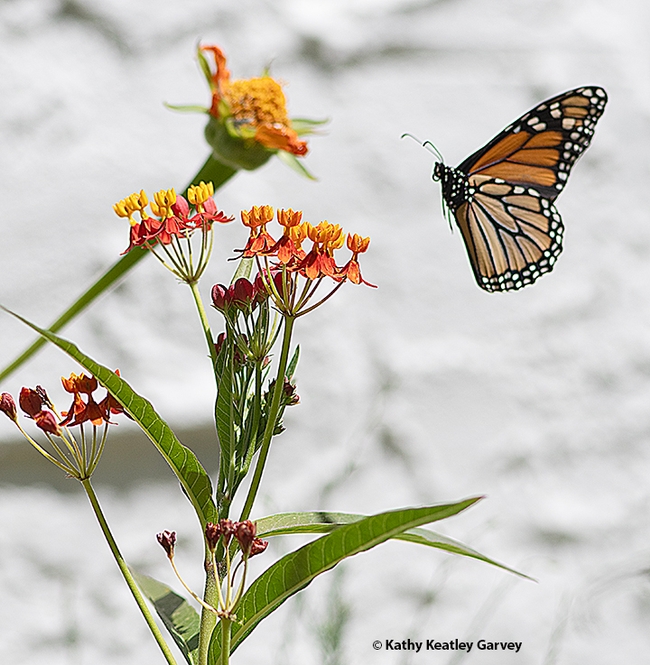
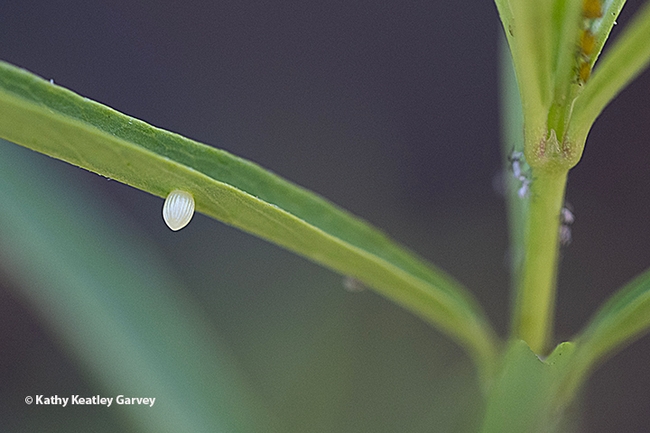
- Author: Kathy Keatley Garvey
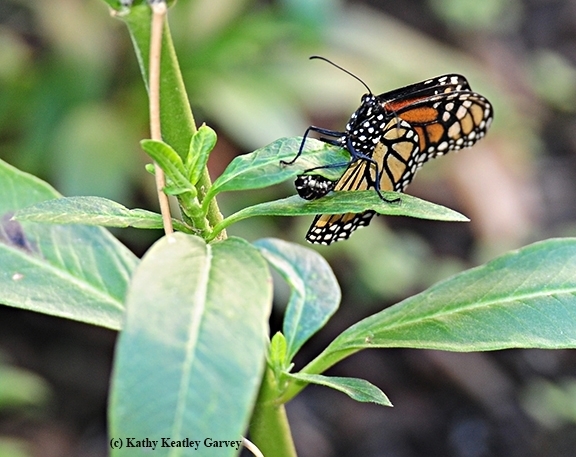
Apparently so, from personal observation.
Over the years, we've grown multiple species of milkweed in our pollinator garden in Vacaville, Calif. We give them a choice. The species include:
- Narrow-leafed milkweed, Asclepias fascicularis
- Showy milkweed, A. speciosa
- Pleurisy root, A. tuberosa
- Tropical milkweed, A. curassavica
- Hairy balls or balloonplant, Gomphocarpus physocarpus
Which species do they prefer? Tropical milkweed, hands down. But it's a plant that's become highly controversial in California. Friends unfriend friends, and the unfriended lash out with how "bad" tropical milkweed is and how "uneducated" the messenger is. "Don't you know about Ophryocystis elektroscirrha (OE)?" they ask. "How dare you plant tropical milkweed? Yank it out!"
Meanwhile, the monarchs keep monarching. And we keep observing them.
Consider the male monarch spotted lying in the middle of a residential street in west Vacaville the morning of Jan. 3. It was there despite the rain, the cold and the passing cars. What will happen to it? Will it find a mate? Will its mate be able to find a milkweed to deposit her eggs? She certainly won't find native milkweed, such as A. fascicularis and A. speciosa, but she might find A. curassavica.
If. She. Is. Lucky.
Mona Miller, administrator of the educational Facebook page, Creating Habitat for Butterflies, Moths and Pollinators, recently shared a post that should be "food for thought" (for us) and that should result in "more food" (milkweed) for the monarchs. Her Facebook page focuses on "the preservation and protection of North American butterflies, moths and pollinators, particularly the Monarch butterfly."
"All milkweeds get Ophryocystis elektroscirrha (OE)," Miller wrote. "There are native milkweeds that are viable in the fall and winter. Tropical milkweed, due to their high level of toxins (cardenolides), are very medicinal. Monarch females choose tropical milkweeds over less toxic native plants to self-medicate. In October 2022, there was a discussion on the Monarch Watch email list. Dr. (Orley "Chip") Taylor (founder and director of Monarch Watch and a professor in the Department of Ecology and Evolutionary Biology at the University of Kansas) said that tropical milkweed does not stop the migration. He said more native and tropical milkweed should be planted. He said the more milkweed that is available the less spores will be left on all milkweeds. Fewer milkweeds leave monarchs visiting available milkweeds and leaving more spores. You can read the discussion here, there are several posts: https://lists.ku.edu/pip.../dplex-l/2022-October/012192.html."
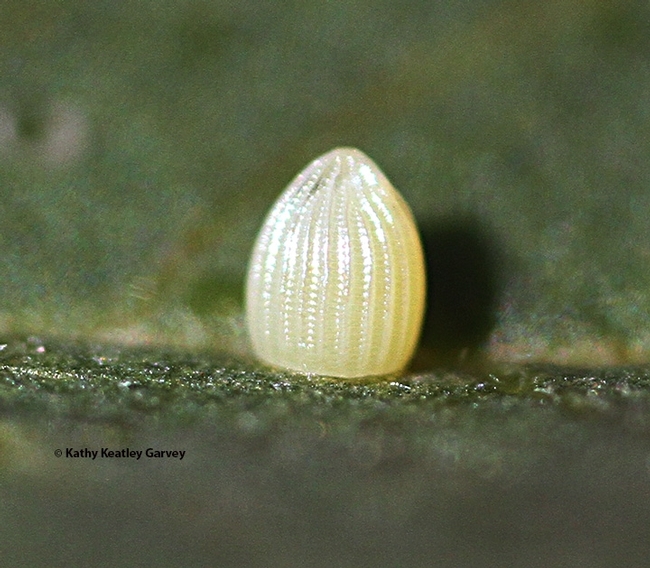
"Actually, the best strategy is to plant more milkweeds, both native and tropical," Professor Taylor wrote, explaining that "First, the interactions between monarchs, milkweed and O.E. are frequency and density dependent. What this means is that spore loads on foliage are dependent on the abundance of milkweed relative to the number of ovipositing females. The O.E. infection rate is a function of this dynamic. Second, because of these relationships, O.E. cycles. That is, it increases and then declines only to increase again. There is a seasonal pattern to these cycles with low rates in the spring and higher rates about 3-4 generations. Third, the interactions that contribute to cycling involve spatial relationships that include distances between resources (milkweed patches) and the search capabilities of the butterflies. There is a time component as well."
"Here is the scenario that could play out from San Diego to Ventura counties and parts of Marin as well," Taylor wrote. "Due to warmer conditions more and more native milkweeds (mostly fascicularis) remain green during the winter. This appears to be happening over a broad area. With the sale of tropical milkweed (hereafter TM) being prohibited and homeowners being discouraged from growing TM, what is the likely outcome? With fewer milkweeds overall, the O.E. spore count will go up on both native and TM. OE will become more common rather than less. Further, the reduced distribution of milkweeds will reduce the opportunity for O.E. to cycle. Cycling depends on part of the milkweed distribution being relatively free of spores for the monarch population to recover. Overall, there will be fewer butterflies surviving the winter and therefore a lower starting population in the spring. If that happens, there will be fewer monarchs through the entire season. So, instead of leading to lower O.E. and more butterflies, the elimination of TM is likely to reduce the monarch population--in effect taking the butterflies away from the people. Again, in addition to cutting back TM from time to time to reduce O.E., an alternative solution is to grow TM and to see that it is hyper-dispersed in gardens, etc. through the 5-county area. The same strategy would involve A. fascicularis and other native milkweeds."
"Some of the reaction to TM is simply based on the notion that it is non-native," Taylor wrote. "We can agree on that point. However, it does not naturalize and therefore is not invasive. Our gardens are filled with such plants. TM supports populations of monarchs as far south as Peru and in most, if not all, places where monarchs have been introduced. Also, since this species flowers nearly continuously through the growing season, it is a source of nectar for a large number of pollinating species. TM supports monarchs--full stop! Let's learn to live with it. More milkweeds equal more monarchs and less O.E. overall."
Taylor went on to say that TM does not cause monarchs to break diapause and become reproductive. "Dingle suggests that it is temperature that causes monarchs to break diapause and that is exactly what I have been saying for years. Hormone production is a function of temperature--head temperatures--and not contact with plants. The major driver in the West has been and will continue to be weather/climate. It starts with the conditions that determine the size and distribution of the overwintering female numbers and their reproductive success."
However, the California Department of Food and Agriculture (CDFA), influenced by conservation groups, has categorized A. curassavica as "a noxious weed," and county agricultural commissioners have banned the sale of the plant in nurseries in Marin, Contra Costa, San Mateo and Ventura counties.
Professor Dingle bears to differ. "No one should rush out and pull out their tropical milkweed as it would be a waste of time and effort," he says. "Nurseries should also be able to continue to sell it." He points out:
- "There is not enough tropical milkweed planted to have much influence (see the amount of A. syriaca and A. fascicularis throughout the American west not to mention various other species like A. erosa, cordifolia, californica, etc.) Yes, there are parasites on A. curassavica as there are on ALL milkweeds."
- "There are populations of monarchs that are doing just fine feeding exclusively on A. curassavica (e.g. on many Pacific Islands, such as Guam where I have studied them.
- "Migration and the diapause that accompanies it in the fall are determined by shortening photoperiod and temperature (warm temps can override short days hence the issue with climate change). There is no significant influence of food plant."
UC Davis distinguished professor Art Shapiro, who has monitored butterfly populations in central California since 1972, says the "anti-curassavica propaganda is total hogwash. I have been saying so for years."
Curious, isn't it, that a plant can be so controversial? Four states, California, Arizona, New Mexico and Texas, border Mexico. On the California side, inches away from the Mexican border, tropical milkweed is considered a "noxious weed" per the CDFA definition. On the other side, in Mexico, it's simply a great host plant for monarchs.
What does 2023 hold for the iconic monarch and its host plants? For one thing, more scientific research is needed.
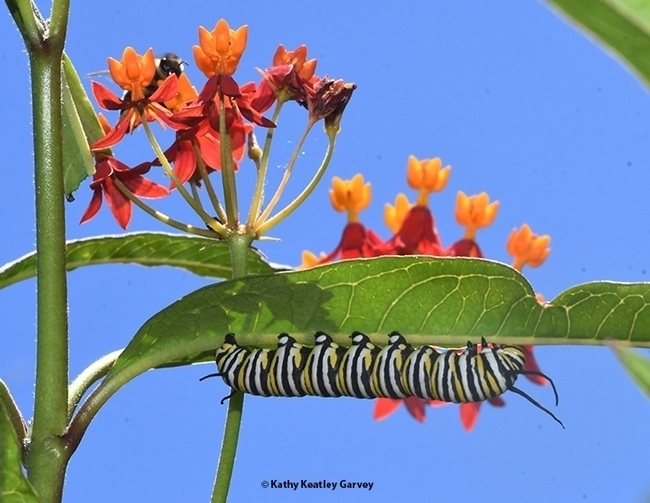
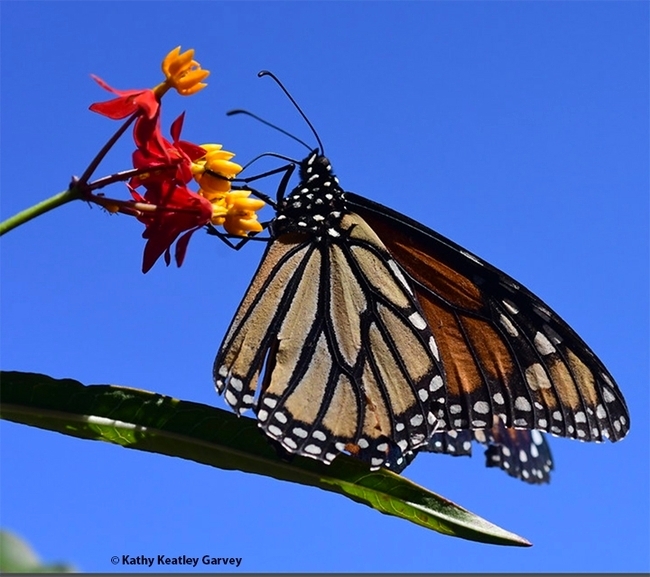
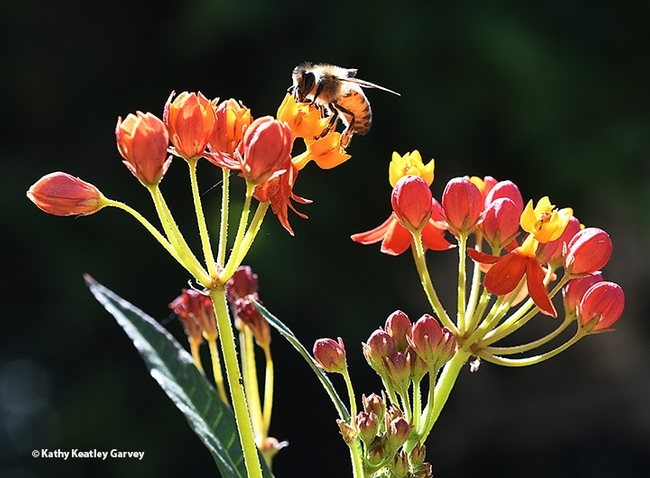
- Author: Kathy Keatley Garvey

Fact: Without milkweed, no monarchs.
Yet a milkweed species that's been thriving in California for more than a century is getting a bad rap. The California Department of Food and Agriculture (CDFA), apparently influenced by conservation groups, has categorized Asclepias curassavica, commonly known as tropical milkweed, as "a noxious weed."
That means, among other things, that county agricultural commissioners can ban the sale of tropical milkweed in nurseries. Indeed, several counties, including Marin, Contra Costa, San Mateo and Ventura, already have.
Banned for sale in nurseries? Says entomologist Jeff Smith, who curates the Lepidoptera collection at the Bohart Museum of Entomology: "There are PLENTY of other 'noxious' weeds sold in nurseries (eucalyptus?) that don't seem to raise the hackles of these counties, so it appears more political than factual, and coming up with the supposed pathogens-on-the-plants scenario looks like they searched for an excuse."
Fact: Infected monarch butterflies can deposit microscopic protozoan parasites, Ophryocystis elektroscirrha or OE, on milkweed. That's ALL species of milkweed, not just tropical. Tropical, however, does not die back in the winter in some parts of California, and that, some argue, encourages monarchs to continue to breed and impedes their migration to overwintering sites. Some blame this "continued OE exposure" to the decline of the monarch population.
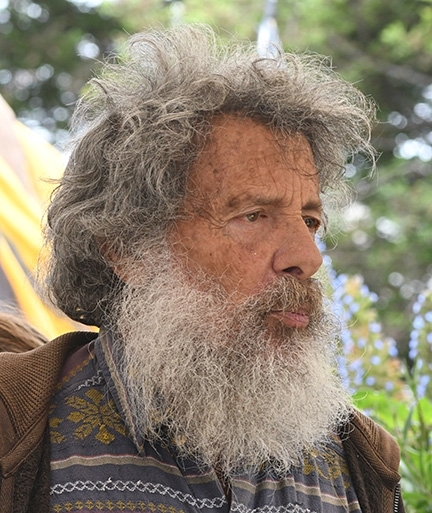
Hugh Dingle, distinguished professor emeritus of entomology, behavior and evolution at UC Davis and now a Marin County resident, is an internationally known expert on animal migration. He's researched animal migration for some 50 years. In the last 20 years or so, he has focused on monarch butterflies. He has authored two editions of Migration: The Biology of Life on the Move and some 100 papers. National Geographic featured Professor Dingle in its cover story on “Great Migrations” in November 2010. LiveScience interviewed him for its November 2010 piece on “Why Do Animals Migrate?” (See news story that includes his biographical information)
Professor Dingle responded to a recent front-page article in a Marin County paper about the ban on tropical milkweed. Banning tropical milkweed will NOT save the monarch, Dingle told the reporter in an email. In fact, he said, the ban will "essentially have zero effect on monarchs" and "no one should rush out and pull out their tropical milkweed as it would be a waste of time and effort. Nurseries should also be able to continue to sell it."
The contents of his email, which the professor shared with Bug Squad, include:
- "There is not enough tropical milkweed planted to have much influence (see the amount of A. syriaca and A. fascicularis throughout the American west not to mention various other species like A. erosa, cordifolia, californica, etc.) Yes, there are parasites on A. curassavica as there are on ALL milkweeds."
- "There are populations of monarchs that are doing just fine feeding exclusively on A. curassavica (e.g. on many Pacific Islands, such as Guam where I have studied them.
- "Migration and the diapause that accompanies it in the fall are determined by shortening photoperiod and temperature (warm temps can override short days hence the issue with climate change). There is no significant influence of food plant."
They Should Know Better! Dingle said some of the advice that CDFA received to categorize A. curassavica as a "noxious weed" came from conservation groups. "They should know better!" he declared.
Art Shapiro, UC Davis distinguished professor of evolution and ecology, has been researching the butterfly populations (including monarchs) of central California for more than 50 years. He co-authored the well-cited research article, "Understanding a Migratory Species in a Changing World: Climatic Effects and Demographic Declines in the Western Monarch Revealed by Four Decades of Intensive Monitoring," published online in March of 2016 in the journal, Population Ecology.
Professor Shapiro shared this email with Bug Squad:
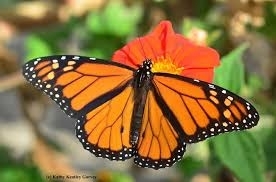
So, What Happened? We asked Professor Dingle how tropical milkweed went from total acceptance to a bad reputation. "I don't know why tropical milkweed got such a bad reputation," he responded in an email. "A couple of possibilities: in some places tropical milkweed seems to have more of the Oe parasite than temperate species which die back in winter--ergo, butterflies pick up more parasites (Fact is not enough to have much influence on migration or breeding although in some places there can be a little. But over the whole range of monarchs . . .naaah!) Second possibility is since tropical is around longer, butterflies can feed on it longer and so might 'keep butterflies from migrating.' BUT...migration is a photoperiodic phenomenon (occurs with short days) so feeding is irrelevant. Besides during migration monarchs will feed on almost any plant with nectaring flowers!"
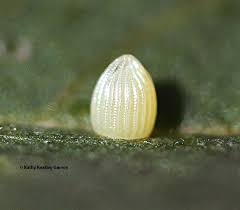
"Monarch butterflies are dependent upon milkweed as its host plant. They lay their eggs on milkweed and their caterpillars eat milkweed. In the past, monarchs in California spent the winter roosting in trees along the coast of California. They did not breed during the winter. They moved inland during summer months where they bred."
"Because of global warming, monarchs have begun to breed during the winter months in California and the existence of tropical milkweed in gardens in coastal California has made that possible...The Nature Police have succeeded in getting the sale of tropical milkweed banned in Contra Costa, Marin, San Mateo and Ventura counties. Academic entomologists have pushed back against this harmful ban in an article published by The Monterey Herald, San Jose Mercury, Marin Independent Journal, and East Bay Times.
The milliontrees.me website also points out that:
- Hugh Dingle, a retired University of California at Davis entomology professor who has studied monarch butterfly migration for more than two decades, said the bans are “basically a wasted effort” and that the focus should be on larger threats such as pesticide and herbicide use. All species of milkweed carry parasites that can affect monarch populations."
- “Arthur Shapiro, a UC Davis professor who has studied monarch butterflies for the past six decades, described the rationale behind the bans as “hogwash.” Shapiro, Dingle and other researchers said winter breeding among monarch butterflies is a relatively new behavior and one influenced by warmer winter temperatures caused by climate change.”
- “David James, an associate entomology professor at Washington State University who has studied monarch butterfly breeding and migration in the Bay Area, said there is a case to be made about the tropical milkweed as being a vital resource for the monarchs in a changing climate.”
- “Leslie McGinnis, a UC Berkeley doctoral candidate studying monarch populations and working with gardeners in the East Bay, said the bans take a 'simplistic view' of the threats that monarchs face, including the fact that many native milkweed plants supplied to nurseries can also be sprayed with pesticides. The bans, she said, can work to disenfranchise or demonize people that have tropical milkweed who instead could be partners in working to help restore monarch populations.”
Indeed, the website minces no words: "Native plant advocates are wedded to a past that is long gone. The climate has changed and it will continue to change. Monarchs and other animals are trying to adapt to the changed conditions. Their survival depends on their ability to adapt. The native plant movement has become a form of climate change denial. Their irrational hatred of introduced plants is damaging the environment with herbicides and harming wildlife. There is no evidence that tropical milkweed is harmful to monarchs."
Mona Miller, who administers the popular Facebook page, Creating Habitat For Butterflies, Moths, & Pollinators, related in a recent post: "Monarch are resilient insects, they have so many strategies to increase their population, but they do have their limits. We must stop pulling out tropical milkweed and cutting it back. Washing off all milkweed should suffice to clean off the OE spores. I emailed several scientists, no one could tell me that OE (Ophryocystis elektroscirrha is a protozoan parasite) has any way to attach to milkweed leaves other than getting caught in the hairs. Tropical milkweed has smooth leaves. Tropical milkweed has been in California since 1909, that is over 100 years. Totally eradicating tropical milkweed, just like totally eradicating all the eucalyptus trees, would have a detrimental effect on the monarch population, perhaps it already has." (Both eucalyptus and tropical milkweed are non-natives.)
Personal Experience. As an aside, our family has provided several species of milkweed in our pollinator garden in Vacaville for more than a decade. The species now include narrowleaf milkweed, A. fascicularis; butterflyweed, A. tuberosa; showy milkweed, A. speciosa; and tropical, A. curassavica. One season we counted more than 300 eggs and caterpillars on the milkweed. Almost all favored A. curassavica. Second choice: A. fascicularis. Some scientists say that perhaps tropical milkweed offers more toxins, and monarchs "know what they want and need."
We continue to plant both natives and non-natives in our thriving garden. The practice now seems so highly controversial that sometimes we feel as if we must mark ourselves "safe" from negativity. But as Professor Shapiro told Bay Nature in June 2022: "I am sick to death of being told you must use natives, especially if a butterfly has no more interest in it than a fire hydrant."
Additional Resources:
- Milliontrees.me:
The Consequences of Putting Plants into 'Native' Strait-Jackets - "Monarch Butterfly Experts Fault Marin Tropical Milkweed Ban," published in, among others:
Ukiah Daily Journal
Marin Independent Journal
Chronicles Live - Xerces Society of Invertebrate Conservation
Monarchs in Decline
Native Milkweeds - Bug Squad:
What's Happening with Our Western Monarch?
